Table of Contents
Technology stacks have never been more expansive—or more chaotic. The average organization now uses hundreds of software tools to power everything from collaboration to customer experience. Yet most companies lack the visibility and governance needed to manage these tools effectively. As a result, software spending is up, risks are higher, and efficiency is harder to achieve.
This article explores how tech stack management has evolved and why it’s now a business imperative in 2025. We’ll look at why the right strategy can help companies go from reactive to proactive, reduce waste, and regain control over their software environments.
What Is a Tech Stack—and How Has It Evolved?
A tech stack refers to the full suite of software applications and tools a company uses to operate. Historically, this was a limited list—email, file storage, and a handful of core business systems. But with the rise of SaaS, cloud infrastructure, and AI-powered tools, modern tech stacks have grown dramatically in size and complexity.
Today’s software tech stack spans functions and teams, often procured outside of centralized IT oversight. Shadow IT, line-of-business purchases, and decentralized decision-making mean the average organization now runs 275 SaaS applications. That makes software stack management not just a technical challenge, but a financial and operational one, too.
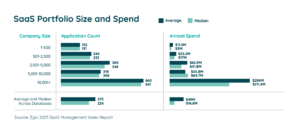
Why Tech Stack Management Matters More Than Ever in 2025
SaaS spend is climbing at an unsustainable pace. The 2025 SaaS Management Index reveals that average annual SaaS spending has increased 9.3% year-over-year, reaching $49M per organization. Spending per employee rose even faster—up 21.9% to $4,830 per year. Even Gartner predicts that total SaaS spending will reach $299B in 2025.

Yet this investment often lacks return. License waste, duplicate tools, and underused platforms contribute to $21 million in unused software per company. Worse, organizations underestimate their SaaS spend by 304% on average, meaning many don’t even realize how much they’re spending or where it’s going.
This uncontrolled growth is driven in part by vendor pricing shifts. Providers are layering on AI features, switching to usage-based models, and increasing complexity in contract structures—all of which inflate costs. Without an effective strategy to monitor and optimize spend, organizations face mounting financial risk and a bloated, inefficient software environment.
Company Tech Stack Examples
To understand the scope of a modern company tech stack, look at how leading organizations manage theirs. Below are two examples of different industries and the different applications they may use to keep operations running smoothly.
Technology Company (10k+ Employees)
- 1. Expense Management: Concur
- 2. Payroll: ADP
- 3. ERP: Netsuite
- 4. API Development: OpenAI API
- Application Performance Management: Datadog
- 6. Data Visualization: Tableau
- CRM: Salesforce
- Project Management: Asana
- 9. Identity Management: Okta
- 10. Service Desk: ServiceNow
- 11. Office Suite: Google Workspace
- Web Conferencing: Zoom

Pharmaceutical Company (10k+ Employees)
- Expense Management: Concur
- Payroll: ADP
- ERP: SAP ERP
- Data Visualization: Microsoft Power BI
- CRM: Veeva CRM
- File Storage & Sharing: Dropbox
- Project Management: Microsoft Project
- Identity Management: SailPoint IdentityIQ
- Service Desk: ServiceNow
- Office Suite: Microsoft 365
- Web Conferencing: Zoom
- Contact Center: Genesys
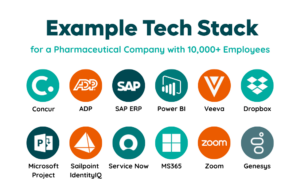
The apps in these stacks are just a sample of what can be found within the greater software portfolio. Today, the average enterprise has 660 apps and adds 12 new ones each month, illustrating just how broad modern tech stacks can become.
Managing your software environment effectively starts with visibility. Most importantly, it demands proactive stack management practices, continuous optimization, and governance frameworks that support both innovation and control.
Software Tech Stack by Department, Industry, or Vertical
Every department has its own ecosystem of tools—and managing these tech stacks across functions adds complexity fast. What begins as a handful of must-have platforms can quickly expand into dozens of niche tools, often procured outside centralized IT. The result? Fragmentation, overlapping features, and wasted spend.
Understanding software stack management at the department level helps teams pinpoint redundancies, benchmark their tooling, and ensure alignment with business goals. Here are examples of common stacks by team.
Marketing Tech Stack
Marketing teams often lead the charge in software adoption—and their stacks are among the most bloated. According to the 2025 Marketing Technology Landscape by Chief Martec, there are now 14,106 martech solutions available, a 100x increase since 2011. AI-powered tools are accelerating this trend.
A typical marketing tech stack may include:
- HubSpot or Marketo (marketing automation)
- Google Analytics or Amplitude (web analytics)
- Canva or Adobe Creative Cloud (content creation)
- Hootsuite or Sprout Social (social media management)
- SEMrush or Ahrefs (SEO tools)
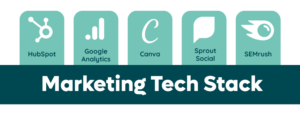
Sales Software Stack
Sales organizations rely on CRMs and prospecting tools to drive pipeline growth. However, with overlapping capabilities across sales engagement, forecasting, and contract automation, these stacks often balloon.
Common tools include:
- Salesforce or HubSpot (CRM)
- Outreach or Salesloft (sales engagement)
- ZoomInfo or LinkedIn Sales Navigator (lead sourcing)
- Gong or Chorus (call intelligence)
- DocuSign or PandaDoc (contract management)
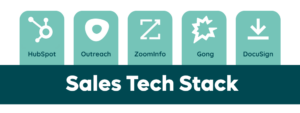
Human Resources Tech Stack
HR teams juggle everything from hiring to compliance, but /often use fragmented platforms to do it. Managing licenses across tools with overlapping people management features is a growing challenge.
HR stacks might include:
- Workday or BambooHR (HRIS)
- Greenhouse or Lever (applicant tracking)
- Lattice or 15Five (performance management)
- Gusto or ADP (payroll)
- LinkedIn or Indeed (recruiting platforms)

Finance Tech Stack
Finance teams lean heavily on accounting, planning, and spend management tools. But as procurement shifts toward SaaS, visibility into software spend becomes more important than ever.
A typical finance stack may include:
- QuickBooks or NetSuite (accounting)
- Coupa or SAP Concur (expense management)
- Anaplan or Adaptive Insights (financial planning)
- Bill.com or Tipalti (accounts payable)
- Zylo (SaaS spend visibility and optimization)
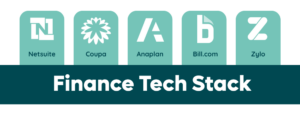
IT and Engineering Tech Stack
IT and engineering teams maintain the infrastructure—and also use tools for development, monitoring, and support. These are often among the largest and most diverse stacks in the organization.
These stacks may include:
- AWS or Azure (cloud infrastructure)
- Jira or Asana (project management)
- GitHub or GitLab (code repositories)
- Datadog or New Relic (monitoring and observability)
- Okta or Duo (identity and access management)
- Zylo (SaaS risk visibility and license management)
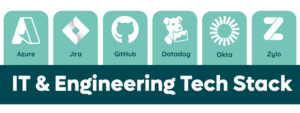
How to Build an Effective Software Tech Stack
Managing a growing stack of tools starts with intention. Too many companies default to reactive software acquisition—adding tools in response to short-term needs without broader oversight. Building an optimal software tech stack requires a thoughtful, scalable approach that aligns tools with strategic goals, budgets, and processes.
Here’s how to create a stack that works now and adapts over time.
Assess Business Needs
Every effective stack begins with a clear understanding of business requirements. Identify the core functions your software must support—whether that’s customer acquisition, product development, or employee experience. Engage key stakeholders across departments to map out priorities, pain points, and functional gaps. This step ensures your software strategy is solving the right problems from the start.
Establish a Budget Framework
Software budgets are no longer just an IT concern—they now involve procurement, finance, and business unit leaders. Establish a cross-functional budget process that accounts for both annual licensing costs and variable usage-based pricing. Use historical spend data to model growth, flag waste, and set thresholds for renewals and new purchases. Companies are spending an average of $4,830 per employee per year on SaaS, making clear budget visibility essential.
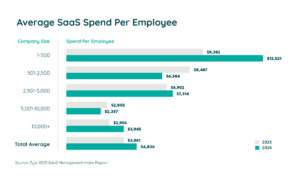
Audit and Analyze Your Existing Stack
Before adding new tools, analyze what you already have. Most organizations underestimate their SaaS inventory and overspend on unused or redundant apps. A tech stack audit should include:
- Total number of apps
- Licenses owned vs. used
- Tool overlap by function
- Renewal timelines
- Owner and cost center visibility
Companies now manage an average of 275 SaaS applications—and that number can climb into the thousands without proper oversight.
Streamline Your Software Tech Stack
Rationalizing your stack is essential to reduce costs and complexity. Eliminate redundant tools with overlapping features, consolidate vendors where possible, and prioritize enterprise-grade platforms with strong adoption. Stack management isn’t just about cutting—it’s about creating space for the tools that drive real value.
Prioritize Integrations
Disconnected software slows workflows and creates organizational and data silos. Look for tools that integrate seamlessly with your core systems, such as CRM, ERP, or project management platforms. Integration helps reduce friction, ensures data continuity, and improves adoption across teams. Consider how well new tools will connect to your existing stack before you buy.
Evaluate AI Readiness
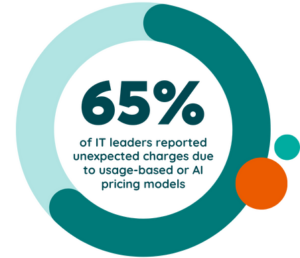 AI is rapidly reshaping how software works. But adding AI-powered tools without structure leads to cost creep and governance risk. Evaluate where AI capabilities already exist in your stack and where they can be added for real impact. Be wary of inflated pricing models that bundle AI without transparency. Build policies now to define where and how AI can be deployed responsibly.
AI is rapidly reshaping how software works. But adding AI-powered tools without structure leads to cost creep and governance risk. Evaluate where AI capabilities already exist in your stack and where they can be added for real impact. Be wary of inflated pricing models that bundle AI without transparency. Build policies now to define where and how AI can be deployed responsibly.
Zylo’s 2025 SaaS Management Index shows that many IT leaders have already been caught off guard by AI pricing. In our survey, 65% of IT leaders surveyed reported unexpected charges on SaaS due to consumption-based or AI pricing models.
Create a Governance Process for Buying Software
Without a defined process for software acquisition, shadow IT thrives. Set clear governance policies for purchasing, including:
- Who can request or approve software
- Required security and compliance checks
- Procurement workflows and intake forms
- Centralized vendor reviews and legal approvals
Governance doesn’t have to mean red tape. When well-designed, it supports agility by helping teams get the right tools faster—with full visibility and control.
6 Best Practices for Adding New Technology to Your Software Stack
Adding a new tool to your company tech stack might feel like a quick fix. But without a structured approach, it can lead to overlap, cost sprawl, and security risks. A scalable stack strategy goes beyond managing what you already have. It also requires knowing when and how to introduce new solutions.
Here are some key steps to follow before adopting a new application.
1) Identify a Functional Gap
Start by confirming there’s a legitimate need the current stack can’t meet. Is a team struggling with outdated workflows? Are manual tasks slowing down output? Define the use case clearly—and check whether any existing tools already have that functionality. Many teams request new apps simply because they’re unaware of what’s available within the company’s current stack.
2) Empower Teams to Request Tools Transparently
In 2025, only 26% of SaaS spend is managed by IT-–the remaining 74% comes from business units or employees. These employees are often closest to the problems software solves, which is driving the rise of Shadow IT. To prevent this, make it easy for them to request tools—but within a visible, centralized system. Intake forms or ticketing systems tied to procurement workflows help track demand, avoid duplicate purchases, and surface opportunities for broader value.

3) Evaluate Scalability and Fit
Before committing to a tool, ask whether it can grow with your business. Tools with rigid licensing models or weak enterprise support may work for a pilot team but fall short at scale. Assess:
- User limits and license tiers
- Admin controls and role-based access
- Vendor support for enterprise needs
Stack management isn’t just about solving today’s problems—it’s about preparing for tomorrow’s growth.
4) Ensure Seamless Integration
The best tools extend the value of your existing systems. Confirm that the new software integrates with critical platforms—like your CRM, HRIS, or data warehouse—before you buy. Native integrations reduce the need for custom development and boost adoption by making workflows more seamless.
5) Pilot Before You Deploy
Before rolling out a tool to an entire department, run a structured pilot. Test adoption, usability, and ROI in a low-risk environment. Gather feedback from early users and monitor key metrics like feature utilization and task completion rates. Piloting helps de-risk purchases and gives stakeholders confidence in long-term value.
6) Track Performance Post-Adoption
Once a tool is in place, its performance should be continuously measured. Use defined KPIs tied to business goals—such as time savings, engagement rates, or conversion improvements. Periodic evaluations prevent “set it and forget it” scenarios that lead to shelfware. Stack management is a living process, not a one-time checklist.
The Role of AI in Modern Software Tech Stacks
AI has quickly become foundational to how software is built, priced, and used. As SaaS vendors race to embed artificial intelligence into their platforms, tech stack management must evolve to address new risks, costs, and opportunities. Whether you’re deploying AI-native tools or evaluating AI add-ons in existing contracts, understanding its impact is key to staying in control.
AI Adoption Is Growing Rapidly
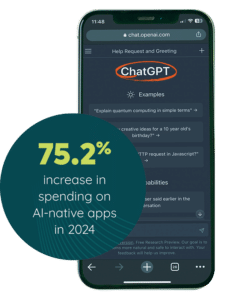 Enterprise use of AI-powered software has accelerated across nearly every department. AI-native app spending surged 75.2% year-over-year —a signal that businesses aren’t just experimenting with AI. They’re investing heavily in tools built with it at their core.
Enterprise use of AI-powered software has accelerated across nearly every department. AI-native app spending surged 75.2% year-over-year —a signal that businesses aren’t just experimenting with AI. They’re investing heavily in tools built with it at their core.
AI now appears in everything from CRMs to design platforms, often with the promise of automation, efficiency, or personalization. But as adoption grows, so does the need for stack governance practices that account for how—and why—AI tools are being added.
AI Pricing Models Are Changing SaaS Cost Structures
The rapid rise of AI in SaaS is disrupting traditional pricing strategies. Many vendors are introducing AI as a premium add-on or launching entirely new usage-based billing models. This makes it harder for finance and procurement teams to forecast costs or compare tools on equal footing.
Without pricing transparency, organizations risk overpaying for unused features—or paying twice for similar AI capabilities across tools. Effective software tech stack management now requires deeper contract scrutiny and performance monitoring to ensure AI investments deliver real ROI.
Security Risks in AI-Driven SaaS
With the rise of generative and predictive AI, data governance concerns are front and center. AI tools may contain sensitive company or customer data, and without clear controls, that opens the door to risk.
These days, 89.4% of IT leaders are concerned about security risks related to AI in their SaaS environments. Their concerns include data leakage, IP exposure, and lack of model transparency. For organizations looking to scale AI use, embedding security reviews and vendor risk assessments into the stack onboarding process is a necessity.
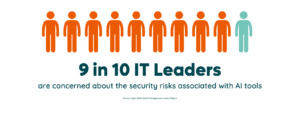
The Future of Company Tech Stack Management
The size and complexity of the modern software tech stack isn’t slowing down. As AI adoption grows, vendors shift pricing models, and teams continue to procure tools independently, the challenge of managing the stack will only intensify. But with the right strategy, visibility, and tooling, chaos doesn’t have to be the default.
Future-ready organizations will prioritize continuous optimization over one-time cleanups. They’ll invest in centralized governance, normalize collaborative budgeting, and use data to drive smarter software decisions. Above all, they’ll treat stack management as a shared responsibility across IT, finance, and business leaders.
The Definitive Guide to SaaS Management
Learn MoreFrom Stack Chaos to Stack Control, Powered by Zylo
Tech stack chaos isn’t just a software problem—it’s a business risk. Without visibility, governance, and cost controls, even the most innovative companies end up with bloated budgets, underused licenses, and misaligned tools. That’s where Zylo comes in.
Zylo is the leading SaaS Management platform built for the modern enterprise. With it, you get a complete view of your entire software environment across all departments, spend categories, and user levels. Whether you’re centralizing procurement, navigating complex renewals, or assessing AI adoption, you get the data, automation, and workflows to manage it all.
Companies that use Zylo can:
- Uncover hidden SaaS tools and shadow IT across teams.
- Reclaim millions in wasted licenses and shelfware.
- Monitor and manage the surge in AI-native application spend.
- Create repeatable, compliant software acquisition processes.
- Empower stakeholders with the right tools—at the right time and cost.
The future of software tech stack management demands more than manual spreadsheets and guesswork. Zylo turns fragmented stacks into strategic assets—helping you scale smarter, spend better, and stay in control.
Ready to simplify your stack and unlock measurable value? Explore the platform or connect with our team to see what Zylo can do for you.

